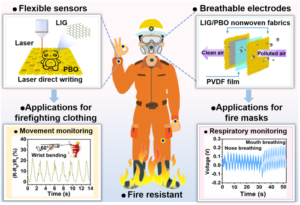Firefighting may look vastly different in the future thanks to intelligent fire suits and masks developed by multiple research institutions in China.
Researchers published results showing breathable electrodes woven into fabric used in fire suits have proven to be stable at temperatures over 520ºC. At these temperatures, the fabric is found to be essentially non-combustible with high rates of thermal protection time at the maximum values recorded so far for such technology at 18.91 seconds.

Scientists from multiple institutions address the challenges and limitations of current fire-fighting gear by introducing wearable, breathable sensors and electrodes to better serve firefighters. CREDIT Nano Research, Tsinghua University Press
The study was published on January 12, 2023 in Nano Research.
The results show the efficacy and practicality of Janus graphene/poly(p-phenylene benzobisoxazole), or PBO, woven fabric in making firefighting “smarter” with the main goal being to manufacture products on an industrial scale that are flame-retardant but also intelligent enough to warn the firefighter of increased risks while traversing the flames.
“Conventional firefighting clothing and fire masks can ensure firemen’s safety to a certain extent,” said Wei Fan, professor and researcher at the School of Textile Science and Engineering at Xi’an Polytechnic University. “However, the fire scene often changes quickly, sometimes making firefighters trapped in the fire for failing to judge the risks in time. At this situation, firefighters also need to be rescued.”
The key here is the use of Janus graphene/PBO, woven fabrics. While not the first of its kind, the introduction of PBO fibers offers better strength and fire protection than other similar fibers, such as Kevlar. The PBO fibers are first woven into a fabric that is then irradiated using a CO2 infrared laser. From here, the fabric becomes the Janus graphene/PBO hybrid that is the focus of the study.
The mask also utilizes a top and bottom layer of Janus graphene/PBO with a piezoelectric layer in between that acts as a way to convert mechanical pressures to electricity, and vice versa.
“The mask has a good smoke particle filtration effect, and the filtration efficiency of PM2.5 and PM3.0 reaches 95% and 100%, respectively. Meanwhile, the mask has good wearing comfort as its respiratory resistance (46.8 Pa) is lower than 49 Pa of commercial masks. Besides, the mask is sensitive to the speed and intensity of human breathing, which can dynamically monitor the health of the firemen” said Fan.
Flame-retardant electronics featured in these fire suits are flexible, heat resistant, quick to make and low-cost which makes scaling for industrial production a tangible achievement. This makes it more likely that the future of firefighting suits and masks will be able to effectively use this technology. Quick, effective responses can also reduce economic losses attributed to fires.
“The graphene/PBO woven fabrics-based sensors exhibit good repeatability and stability in human motion monitoring and NO2 gas detection, the main toxic gas in fires, which can be applied to firefighting suits to help firefighters effectively avoiding danger” Fan said. Being able to detect sharp increases in NO2 gas can help firefighters change course in an instant if needed and could be a lifesaving addition to firefighter gear.
Major improvements can be made in the firefighting field to better protect the firefighters by taking advantage of graphene/PBO woven and nonwoven fabrics. Widescale use of this technology can help the researchers reach their ultimate goal of reducing mortality and injury to those who risk their lives fighting fires.
Yu Luo and Wei Fan are equal contributors of this work along with Yaping Miao, Weichun Chen and Yao Zhang of the School of Textile Science and Engineering at Xi’an Polytechnic University, Huiming Wang of the Department of Chemistry at Tsinghua University, Kai Dong of the Beijing Institute of Nanoenergy and Nanosystems at the Chinese Academy of Sciences, and Lin Hou and Yanyan Xu of Shaanxi Textile Research Institute Co., LTD contributed to this research.
This work was supported by the National Natural Science Foundation of China, Textile Vision Basic Research Program of China, Key Research and Development Program of Xianyang Science and Technology Bureau, Key Research and Development Program of Shaanxi Province, Natural Science Foundation of Shaanxi Province, and Scientific Research Project of Shaanxi Provincial Education Department.
The paper is also available on SciOpen (https://www.sciopen.com/article/10.1007/s12274-023-5382-y) by Tsinghua University Press.